Global CO2 Emission-Related Geotechnical Engineering Hazards and the Mission for Sustainable Geotechnical Engineering
Abstract
1. Introduction
2. Relationship between Climate Change and Geotechnical Engineering Hazards
2.1. Climate Change Issues Related to Global Warming
2.2. Effect of Abnormal Climate Events on Ground Properties and Geotechnical Engineering Hazards
3. Statistical Trends of CO2 (Climate Change) Emission and Geotechnical Engineering Hazards
3.1. Status of Geotechnical Engineering Hazards
3.2. Relationship between CO2 Emissions and Geotechnical Engineering Hazards
4. The Response to Geotechnical Engineering Hazards and the Necessity of an Environmentally Friendly Method
4.1. Contribution from Geotechnical Engineering to Reduction of CO2 in the Earth
4.2. Ground Improvement and CO2 Emissions Related to Cement
4.3. Recent Research on Environmentally Friendly Ground Treatment Methods
4.3.1. Chemical Stabilizers
4.3.2. Geosynthetics
4.3.3. Geopolymers
4.3.4. Microbiologically Induced Calcite Precipitation
4.3.5. Biopolymers
5. Conclusions
Author Contributions
Funding
Conflicts of Interest
References
- Pachauri, R.K.; Allen, M.R.; Barros, V.R.; Broome, J.; Cramer, W.; Christ, R.; Church, J.A.; Clarke, L.; Dahe, Q.; Dasgupta, P. Climate Change 2014: Synthesis Report. Contribution of Working Groups I, II and III to the Fifth Assessment Report of the Intergovernmental Panel on Climate Change; Intergovernmental Panel on Climate Change (IPCC): Geneva, Switzerland, 2014; p. 151. [Google Scholar]
- Schneider, S.H. The greenhouse effect: Science and policy. Science 1989, 243, 771–781. [Google Scholar] [CrossRef] [PubMed]
- Rodhe, H. A comparison of the contribution of various gases to the greenhouse effect. Science 1990, 248, 1217–1219. [Google Scholar] [CrossRef] [PubMed]
- Dlugokencky, E.; Tans, P. National Oceanic & Atmospheric Administraion (NOAA) Earth System Research Laboratory (ESRL). Available online: https://www.esrl.noaa.gov/gmd/ccgg/trends/ (accessed on 7 June 2019).
- Le Quéré, C.; Andrew, R.M.; Friedlingstein, P.; Sitch, S.; Pongratz, J.; Manning, A.C.; Korsbakken, J.I.; Peters, G.P.; Canadell, J.G.; Jackson, R.B. Global carbon budget 2017. Earth Syst. Sci. Data 2018, 10, 405–448. [Google Scholar] [CrossRef]
- Karl, T.R.; Trenberth, K.E. Modern global climate change. Science 2003, 302, 1719–1723. [Google Scholar] [CrossRef]
- Olivier, J.; Schure, K.; Peters, J. Trends in Global CO2 and Total Greenhouse Gas Emissions: 2017 Report; PBL Netherlands Environmental Assessment Agency: Hague, The Netherlands, 2017; p. 69. [Google Scholar]
- Goddard Institute for Space Studies (GISS) at The National Aeronautics and Space Administration (NASA). Global Land-Ocean Temperature Index. Available online: https://climate.nasa.gov/vital-signs/global-temperature/ (accessed on 7 June 2019).
- UNFCCC. Adoption of the Paris Agreement; FCCC/CP/2015/L.9/Rev.1; United Nations Framework Convention on Climate Change (UNFCCC): Bonn, Germany, 2015. [Google Scholar]
- Jackson, R.; Le Quéré, C.; Andrew, R.; Canadell, J.; Peters, G.; Roy, J.; Wu, L. Warning signs for stabilizing global CO2 emissions. Environ. Res. Lett. 2017, 12, 110202. [Google Scholar] [CrossRef]
- Rogelj, J.; Den Elzen, M.; Höhne, N.; Fransen, T.; Fekete, H.; Winkler, H.; Schaeffer, R.; Sha, F.; Riahi, K.; Meinshausen, M. Paris Agreement climate proposals need a boost to keep warming well below 2 °C. Nature 2016, 534, 631–639. [Google Scholar] [CrossRef] [PubMed]
- Aalst, M.K.V. The impacts of climate change on the risk of natural disasters. Disasters 2006, 30, 5–18. [Google Scholar] [CrossRef]
- Trenberth, K.E. Changes in precipitation with climate change. Clim. Res. 2011, 47, 123–138. [Google Scholar] [CrossRef]
- Bouwer, L.M. Have disaster losses increased due to anthropogenic climate change? Bull. Am. Meteorol. Soc. 2011, 92, 39–46. [Google Scholar] [CrossRef]
- Yasuhara, K.; Komine, H.; Murakami, S.; Chen, G.; Mitani, Y.; Duc, D. Effects of climate change on geo-disasters in coastal zones and their adaptation. Geotext. Geomembr. 2012, 30, 24–34. [Google Scholar] [CrossRef]
- Mirza, M.M.Q. Climate change and extreme weather events: Can developing countries adapt? Clim. Policy 2003, 3, 233–248. [Google Scholar] [CrossRef]
- Yasuhara, K.; Murakami, S.; Mimura, N.; Komine, H.; Recio, J. Influence of global warming on coastal infrastructural instability. Sustain. Sci. 2007, 2, 13–25. [Google Scholar] [CrossRef]
- Mukherjee, S.; Nateghi, R.; Hastak, M. A Multi-hazard approach to assess severe weather-induced major power outage risks in the U.S. Reliab. Eng. Syst. Saf. 2018, 175, 283–305. [Google Scholar] [CrossRef]
- National Oceanic and Atmospheric Administration (NOAA). Billion-Dollar Weather and Climate Disasters. Available online: https://www.ncdc.noaa.gov/billions/time-series (accessed on 7 June 2019).
- Ministry of the Interior and Safety. Annual Disaster Report 2016; Ministry of the Interior and Safety: Seoul, Korea, 2017. [Google Scholar]
- National Emergency Management Agency. Annual Disaster Report 2009; National Emergency Management Agency: Seoul, Korea, 2010. [Google Scholar]
- National Research Council. Geological and Geotechnical Engineering in the New Millennium: Opportunities for Research and Technological Innovation; National Academies Press: Washington, DC, USA, 2006. [Google Scholar]
- Chang, I.; Im, J.; Cho, G.C. Introduction of microbial biopolymers in soil treatment for future environmentally-friendly and sustainable geotechnical engineering. Sustainability 2016, 8, 251. [Google Scholar] [CrossRef]
- Huber, M.; Knutti, R. Anthropogenic and natural warming inferred from changes in Earth’s energy balance. Nat. Geosci. 2012, 5, 31–36. [Google Scholar] [CrossRef]
- Trenberth, K.E. Atmospheric moisture residence times and cycling: Implications for rainfall rates and climate change. Clim. Chang. 1998, 39, 667–694. [Google Scholar] [CrossRef]
- Trenberth, K.E.; Dai, A.; Rasmussen, R.M.; Parsons, D.B. The changing character of precipitation. Bull. Am. Meteorol. Soc. 2003, 84, 1205–1217. [Google Scholar] [CrossRef]
- Liu, S.C.; Fu, C.; Shiu, C.J.; Chen, J.P.; Wu, F. Temperature dependence of global precipitation extremes. Geophys. Res. Lett. 2009, 36, L11702. [Google Scholar] [CrossRef]
- Ren, D. Storm-Triggered Landslides in Warmer Climates; Springer: Basel, Switzerland, 2015. [Google Scholar]
- Mimura, N. Sea-level rise caused by climate change and its implications for society. Proc. Jpn. Acad. Ser. B Phys. Biol. Sci. 2013, 89, 281–301. [Google Scholar] [CrossRef]
- Church, J.A.; White, N.J.; Konikow, L.F.; Domingues, C.M.; Cogley, J.G.; Rignot, E.; Gregory, J.M.; van den Broeke, M.R.; Monaghan, A.J.; Velicogna, I. Revisiting the Earth’s sea-level and energy budgets from 1961 to 2008. Geophys. Res. Lett. 2011, 38, L18601. [Google Scholar] [CrossRef]
- Solomon, S.; Qin, D.; Manning, M.; Chen, Z.; Marquis, M.; Averyt, K.B.; Tignor, M.; Miller, H.L. Climate Change 2013: The Physical Science Basis. Contribution of Working Group I to the Fourth Assessment Report of the Intergovernmental Panel on Climate Change; Intergovernmental Panel on Climate Change (IPCC): Cambridge, UK; New York, NY, USA, 2007; p. 996. [Google Scholar]
- Iverson, R.M. Landslide triggering by rain infiltration. Water Resour. Res. 2000, 36, 1897–1910. [Google Scholar] [CrossRef]
- Lyle, R.; Lipovsky, P.; Brideau, M.-A.; Hutchinson, D. Landslides on ice-rich slopes—A geohazard in a changing climate. In Proceedings of the Geotechnical Engineering for Infrastructure and Development: XVI European Conference on Soil Mechanics and Geotechnical Engineering (ECSMGE), Edinburgh, UK, 13–17 September 2015. [Google Scholar]
- Emanuel, K. A statistical analysis of tropical cyclone intensity. Mon. Weather Rev. 2000, 128, 1139–1152. [Google Scholar] [CrossRef]
- Crozier, M.J.; Glade, T. Landslide hazard and risk: Issues, concepts and approach. In Landslide Hazard and Risk; John Wiley & Sons Ltd.: Chichester, UK, 2005; pp. 1–40. [Google Scholar]
- Keefer, D.K.; Wilson, R.C.; Mark, R.K.; Brabb, E.E.; Brown, W.M.; Ellen, S.D.; Harp, E.L.; Wieczorek, G.F.; Alger, C.S.; Zatkin, R.S. Real-time landslide warning during heavy rainfall. Science 1987, 238, 921–925. [Google Scholar] [CrossRef] [PubMed]
- Wieczorek, G.F.; Glade, T.; Jakob, M.; Hungr, O. Climatic factors influencing occurrence of debris flows. In Debris-Flow Hazards and Related Phenomena; Springer: Berlin/Heidelberg, Germany, 2007; pp. 325–362. [Google Scholar]
- Fuchu, D.; Lee, C.; Sijing, W. Analysis of rainstorm-induced slide-debris flows on natural terrain of Lantau Island, Hong Kong. Eng. Geol. 1999, 51, 279–290. [Google Scholar] [CrossRef]
- Arenson, L.U.; Jakob, M. Periglacial Geohazard Risks and Ground Temperature Increases. In Engineering Geology for Society and Territory—Volume 1; Springer International Publishing: Cham, Switzerland, 2015; pp. 233–237. [Google Scholar]
- Highland, L.; Bobrowsky, P.T. The Landslide Handbook: A Guide to Understanding Landslides; U.S. Geological Survey: Reston, VA, USA, 2008.
- Williams, P.J. Permafrost and climate change: Geotechnical implications. Philos. Trans. R. Soc. Lond. A 1995, 352, 347–358. [Google Scholar]
- Haeberli, W.; Beniston, M. Climate change and its impacts on glaciers and permafrost in the Alps. Ambio 1998, 27, 258–265. [Google Scholar]
- Lamoreaux, P.E.; Newton, J. Catastrophic subsidence: An environmental hazard, Shelby County, Alabama. Environ. Geol. Water Sci. 1986, 8, 25–40. [Google Scholar] [CrossRef]
- Waltham, T.; Bell, F.G.; Culshaw, M.G. Sinkholes and Subsidence: Karst and Cavernous Rocks in Engineering and Construction; Springer Science & Business Media: Hidelberg, Germany, 2007. [Google Scholar]
- Huang, W.-C.; Weng, M.-C.; Chen, R.-K. Levee failure mechanisms during the extreme rainfall event: A case study in Southern Taiwan. Nat. Hazards 2014, 70, 1287–1307. [Google Scholar] [CrossRef]
- El Shamy, U.; Aydin, F. Multiscale modeling of flood-induced piping in river levees. J. Geotech. Geoenviron. Eng. 2008, 134, 1385–1398. [Google Scholar] [CrossRef]
- Ojha, C.; Singh, V.; Adrian, D. Determination of critical head in soil piping. J. Hydraul. Eng. 2003, 129, 511–518. [Google Scholar] [CrossRef]
- Williams, M. Climate Change in Deserts; Cambridge University Press: New York, NY, USA, 2014. [Google Scholar]
- Zhu, L.; Gong, H.; Li, X.; Wang, R.; Chen, B.; Dai, Z.; Teatini, P. Land subsidence due to groundwater withdrawal in the northern Beijing plain, China. Eng. Geol. 2015, 193, 243–255. [Google Scholar] [CrossRef]
- Faunt, C.C.; Sneed, M.; Traum, J.; Brandt, J.T. Water availability and land subsidence in the Central Valley, California, USA. Hydrogeol. J. 2016, 24, 675–684. [Google Scholar] [CrossRef]
- Briaud, J.-L.; Chen, H.-C.; Govindasamy, A.; Storesund, R. Levee erosion by overtopping in New Orleans during the Katrina Hurricane. J. Geotech. Geoenviron. Eng. 2008, 134, 618–632. [Google Scholar] [CrossRef]
- Alongi, D.M. Mangrove forests: Resilience, protection from tsunamis, and responses to global climate change. Estuar. Coast. Shelf Sci. 2008, 76, 1–13. [Google Scholar] [CrossRef]
- Vardon, P.J. Climatic influence on geotechnical infrastructure: A review. Environ. Geotech. 2015, 2, 166–174. [Google Scholar] [CrossRef]
- Floods and landslides leave dozens dead and 50 missing in Japan. The Guardian. 7 July 2018. Available online: https://www.theguardian.com/world/2018/jul/07/heavy-rain-floods-and-landslide-leave-more-than-a-dozen-dead-and-50-missing-in-japan (accessed on 7 June 2019).
- West Japan flood victims still living in despair a month after disaster: Survey. The Japan Times. 6 August 2018. Available online: https://www.japantimes.co.jp/news/2018/08/06/national/west-japan-flood-victims-still-living-despair-month-disaster-survey/#.XHOYnzMzaUl (accessed on 7 June 2019).
- Emanuel, K. Increasing destructiveness of tropical cyclones over the past 30 years. Nature 2005, 436, 686–688. [Google Scholar] [CrossRef] [PubMed]
- Paul, S.; Ghebreyesus, D.; Sharif, H.O. Brief Communication: Analysis of the Fatalities and Socio-Economic Impacts Caused by Hurricane Florence. Geosciences 2019, 9, 58. [Google Scholar] [CrossRef]
- The Interactive Relationship between Coastal Erosion and Flood Risk. SAGE Publications. Available online: https://journals.sagepub.com/doi/abs/10.1177/0309133318794498 (accessed on 7 June 2019).
- Ridley, A.; McGinnity, B.; Vaughan, P. Role of pore water pressures in embankment stability. Proc. Inst. Civ. Eng. Geotech. Eng. 2004, 157, 193–198. [Google Scholar] [CrossRef]
- Sanderson, D.; Sharma, A. World Disasters Report 2016; International Federation of Red Cross and Red Cresent Societies (IFRC): Geneva, Switzerland, 2016; p. 276. [Google Scholar]
- Petley, D. Global patterns of loss of life from landslides. Geology 2012, 40, 927–930. [Google Scholar] [CrossRef]
- Barredo, J.I. Normalised flood losses in Europe: 1970–2006. Nat. Hazards Earth Syst. Sci. 2009, 9, 97–104. [Google Scholar] [CrossRef]
- Alcantara-Ayala, I. Geomorphology, natural hazards, vulnerability and prevention of natural disasters in developing countries. Geomorphology 2002, 47, 107–124. [Google Scholar] [CrossRef]
- Hirabayashi, Y.; Kanae, S.; Emori, S.; Oki, T.; Kimoto, M. Global projections of changing risks of floods and droughts in a changing climate. Hydrol. Sci. J. 2008, 53, 754–772. [Google Scholar] [CrossRef]
- Huggel, C.; Stone, D.; Auffhammer, M.; Hansen, G. Loss and damage attribution. Nat. Clim. Chang. 2013, 3, 694–696. [Google Scholar] [CrossRef]
- Thomas, V.; López, R. Global increase in climate-related disasters. Asian Dev. Bank Econ. Work. Pap. Ser. 2015. Available online: http://hdl.handle.net/11540/5274 (accessed on 7 June 2019).
- Centre for Research on the Epidemiology of Disasters (CRED). Emergency Events Database (EM-DAT). Available online: https://www.emdat.be/emdat_db/ (accessed on 7 June 2019).
- Huang, R.; Chen, J.; Huang, G. Characteristics and variations of the East Asian monsoon system and its impacts on climate disasters in China. Adv. Atmos. Sci. 2007, 24, 993–1023. [Google Scholar] [CrossRef]
- Haque, C.E. Perspectives of natural disasters in East and South Asia, and the Pacific Island States: Socio-economic correlates and needs assessment. Nat. Hazards 2003, 29, 465–483. [Google Scholar] [CrossRef]
- Toya, H.; Skidmore, M. Economic development and the impacts of natural disasters. Econ. Lett. 2007, 94, 20–25. [Google Scholar] [CrossRef]
- Raschky, P.A. Institutions and the losses from natural disasters. Nat. Hazards Earth Syst. Sci. 2008, 8, 627–634. [Google Scholar] [CrossRef]
- Padli, J.; Habibullah, M.S.; Baharom, A.H. The impact of human development on natural disaster fatalities and damage: Panel data evidence. Econ. Res. Ekonomska Istraživanja 2018, 31, 1557–1573. [Google Scholar] [CrossRef]
- Shen, G.; Hwang, S.N. Spatial–Temporal snapshots of global natural disaster impacts Revealed from EM-DAT for 1900–2015. Geomat. Nat. Hazards Risk 2019, 10, 912–934. [Google Scholar] [CrossRef]
- Fragaszy, R.J.; Santamarina, J.C.; Amekudzi, A.; Assimaki, D.; Bachus, R.; Burns, S.E.; Cha, M.; Cho, G.C.; Cortes, D.D.; Dai, S.; et al. Sustainable development and energy geotechnology—Potential roles for geotechnical engineering. KSCE J. Civ. Eng. 2011, 15, 611–621. [Google Scholar] [CrossRef]
- Espinoza, D.N.; Kim, S.H.; Santamarina, J.C. CO2 geological storage—Geotechnical implications. KSCE J. Civ. Eng. 2011, 15, 707–719. [Google Scholar] [CrossRef]
- Abramson, L.W. Slope Stability and Stabilization Methods; John Wiley & Sons: Hoboken, NJ, USA, 2002. [Google Scholar]
- Shukla, S.; Sivakugan, N.; Das, B. A state-of-the-art review of geosynthetic-reinforced slopes. Int. J. Geotech. Eng. 2011, 5, 17–32. [Google Scholar] [CrossRef]
- Kourkoulis, R.; Gelagoti, F.; Anastasopoulos, I.; Gazetas, G. Hybrid method for analysis and design of slope stabilizing piles. J. Geotech. Geoenviron. Eng. 2011, 138, 1–14. [Google Scholar] [CrossRef]
- Prashant, A.; Mukherjee, M. Soil Nailing for Stabilization of Steep Slopes Near Railway Tracks; Department of Civil Engineering, Indian Institute of Technology Kanpur: Kanpur, India, 2010. [Google Scholar]
- Lamont-Black, J.; Jones, C.J.F.P.; Alder, D. Electrokinetic strengthening of slopes—Case history. Geotext. Geomembr. 2016, 44, 319–331. [Google Scholar] [CrossRef]
- Sills, G.; Vroman, N.; Wahl, R.; Schwanz, N. Overview of New Orleans levee failures: Lessons learned and their impact on national levee design and assessment. J. Geotech. Geoenviron. Eng. 2008, 134, 556–565. [Google Scholar] [CrossRef]
- Alfaro, M.; Balasubramaniam, A.; Bergado, D.; Chai, J. Improvement Techniques of Soft Ground in Subsiding and Lowland Environment; CRC Press: Boca Raton, FL, USA, 1994. [Google Scholar]
- Jan, V.H. The use of polyurethane in coastal engineering models. In Proceedings of the 5th Conference of the Application of Physical Modelling to Port and Coastal Protection (Coastlab14), Varna, Bulgaria, 29 September–2 October 2014; Volume 2, pp. 178–185. [Google Scholar]
- Andrew, R.M. Global CO2 emissions from cement production, 1928–2017. Earth Syst. Sci. Data 2018, 10, 2213–2239. [Google Scholar] [CrossRef]
- United States Geological Survey (USGS). Cement Statistics and Information. Available online: https://www.usgs.gov/centers/nmic/cement-statistics-and-information (accessed on 7 June 2019).
- Tingle, J.; Newman, J.; Larson, S.; Weiss, C.; Rushing, J. Stabilization mechanisms of nontraditional additives. Transp. Res. Rec. J. Transp. Res. Board 2007, 1989, 59–67. [Google Scholar] [CrossRef]
- Santoni, R.; Tingle, J.; Webster, S. Stabilization of Silty Sand with Nontraditional Additives. Transp. Res. Rec. J. Transp. Res. Board 2002, 1787, 61–70. [Google Scholar] [CrossRef]
- Green, V.S.; Stott, D. Polyacrylamide: A review of the use, effectiveness, and cost of a soil erosion control amendment. In Proceedings of the 10th International Soil Conservation Organization Meeting, Purdue, IN, USA, 24–29 May 1999; pp. 384–389. [Google Scholar]
- Marto, A.; Yunus, M.; Zurairahetty, N.; Pakir, F.; Latifi, N.; Nor, M.; Hakimi, A.; Tan, C.S. Stabilization of marine clay by biomass silica (non-traditional) stabilizers. Appl. Mech. Mater. 2015, 695, 93–97. [Google Scholar] [CrossRef]
- Latifi, N.; Meehan, C.L. Strengthening of montmorillonitic and kaolinitic clays with calcium carbide residue: A sustainable additive for soil stabilization. In Proceedings of the Geotechnical Frontiers 2017, Orlando, FL, USA, 12–15 May 2017; pp. 154–163. [Google Scholar]
- Onyejekwe, S.; Ghataora, G.S. Soil stabilization using proprietary liquid chemical stabilizers: Sulphonated oil and a polymer. Bull. Eng. Geol. Environ. 2015, 74, 651–665. [Google Scholar] [CrossRef]
- Karol, R.H. Chemical Grouting and Soil Stabilization, Revised and Expanded; CRC Press: Boca Raton, FL, USA, 2003; Volume 12. [Google Scholar]
- Ding, Y.; Dai, J.-G.; Shi, C.-J. Mechanical properties of alkali-activated concrete: A state-of-the-art review. Constr. Build. Mater. 2016, 127, 68–79. [Google Scholar] [CrossRef]
- Saravanan, G.; Jeyasehar, C.; Kandasamy, S. Flyash Based Geopolymer Concrete-A State of the Art Review. J. Eng. Sci. Technol. Rev. 2013, 6, 25–32. [Google Scholar] [CrossRef]
- Toniolo, N.; Boccaccini, A.R. Fly ash-based geopolymers containing added silicate waste. A review. Ceram. Int. 2017, 43, 14545–14551. [Google Scholar] [CrossRef]
- Singh, B.; Ishwarya, G.; Gupta, M.; Bhattacharyya, S.K. Geopolymer concrete: A review of some recent developments. Constr. Build. Mater. 2015, 85, 78–90. [Google Scholar] [CrossRef]
- Phetchuay, C.; Horpibulsuk, S.; Arulrajah, A.; Suksiripattanapong, C.; Udomchai, A. Strength development in soft marine clay stabilized by fly ash and calcium carbide residue based geopolymer. Appl. Clay Sci. 2016, 127–128, 134–142. [Google Scholar] [CrossRef]
- Cristelo, N.; Glendinning, S.; Teixeira Pinto, A. Deep soft soil improvement by alkaline activation. Proc. Inst. Civ. Eng. Ground Improv. 2011, 164, 73–82. [Google Scholar] [CrossRef]
- Duxson, P.; Provis, J.L.; Lukey, G.C.; van Deventer, J.S.J. The role of inorganic polymer technology in the development of ‘green concrete’. Cem. Concr. Res. 2007, 37, 1590–1597. [Google Scholar] [CrossRef]
- Provis, J.L.; Van Deventer, J.S.J. Geopolymers: Structures, Processing, Properties and Industrial Applications; Elsevier: Amsterdam, The Netherlands, 2009. [Google Scholar]
- Zhang, M.; Guo, H.; El-Korchi, T.; Zhang, G.; Tao, M. Experimental feasibility study of geopolymer as the next-generation soil stabilizer. Constr. Build. Mater. 2013, 47, 1468–1478. [Google Scholar] [CrossRef]
- Zornberg, J.G.; Christopher, B.R. Chapter 37: Geosynthetics. In The Handbook of Groundwater Engineering, 2nd ed.; Delleur, J.W., Ed.; CRC Press, Taylor & Francis Group: Boca Raton, FL, USA, 2007; Volume 2. [Google Scholar]
- Holtz, R.D. Geosynthetics for Soil Reinforcement: The 9th Spencer J. Buchanan Lecture; College Station Hilton: Seattle, WA, USA, 2001. [Google Scholar]
- Müller, W.W.; Saathoff, F. Geosynthetics in geoenvironmental engineering. Sci. Technol. Adv. Mater. 2015, 16, 034605. [Google Scholar] [CrossRef]
- Haider, N.; Karlsson, S. Loss of Chimassorb 944 from LDPE and identification of additive degradation products after exposure to water, air and compost. Polym. Degrad. Stab. 2001, 74, 103–112. [Google Scholar] [CrossRef]
- Beißmann, S.; Stiftinger, M.; Grabmayer, K.; Wallner, G.; Nitsche, D.; Buchberger, W. Monitoring the degradation of stabilization systems in polypropylene during accelerated aging tests by liquid chromatography combined with atmospheric pressure chemical ionization mass spectrometry. Polym. Degrad. Stab. 2013, 98, 1655–1661. [Google Scholar] [CrossRef]
- Hatami, K.; Grady, B.P.; Ulmer, M.C. Sensor-enabled geosynthetics: Use of conducting carbon networks as geosynthetic sensors. J. Geotech. Geoenviron. Eng. 2009, 135, 863–874. [Google Scholar] [CrossRef]
- Raisinghani, D.V.; Viswanadham, B.V.S. Centrifuge model study on low permeable slope reinforced by hybrid geosynthetics. Geotext. Geomembr. 2011, 29, 567–580. [Google Scholar] [CrossRef]
- Mujah, D.; Shahin, M.A.; Cheng, L. State-of-the-art review of biocementation by microbially induced calcite precipitation (MICP) for soil stabilization. Geomicrobiol. J. 2017, 34, 524–537. [Google Scholar] [CrossRef]
- DeJong, J.T.; Soga, K.; Banwart, S.A.; Whalley, W.R.; Ginn, T.R.; Nelson, D.C.; Mortensen, B.M.; Martinez, B.C.; Barkouki, T. Soil engineering in vivo: Harnessing natural biogeochemical systems for sustainable, multi-functional engineering solutions. J. R. Soc. Interfaces 2010, 8, 1–15. [Google Scholar] [CrossRef] [PubMed]
- Neupane, D.; Yasuhara, H.; Kinoshita, N.; Unno, T. Applicability of Enzymatic Calcium Carbonate Precipitation as a Soil-Strengthening Technique. J. Geotech. Geoenviron. Eng. 2013, 139, 2201–2211. [Google Scholar] [CrossRef]
- Whiffin, V.S.; van Paassen, L.A.; Harkes, M.P. Microbial carbonate precipitation as a soil improvement technique. Geomicrobiol. J. 2007, 24, 417–423. [Google Scholar] [CrossRef]
- Chu, J.; Ivanov, V.; He, J.; Maeimi, M.; Wu, S. Chapter 19—Use of Biogeotechnologies for Soil Improvement. In Ground Improvement Case Histories; Elsevier: Amsterdam, The Netherlands, 2015; pp. 571–589. [Google Scholar]
- Fujita, Y.; Taylor, J.L.; Gresham, T.L.T.; Delwiche, M.E.; Colwell, F.S.; McLing, T.L.; Petzke, L.M.; Smith, R.W. Stimulation of microbial urea hydrolysis in groundwater to enhance calcite precipitation. Environ. Sci. Technol. 2008, 42, 3025–3032. [Google Scholar] [CrossRef]
- Gomez, M.G.; Martinez, B.C.; DeJong, J.T.; Hunt, C.E.; deVlaming, L.A.; Major, D.W.; Dworatzek, S.M. Field-scale bio-cementation tests to improve sands. Proc. Inst. Civ. Eng. Ground Improv. 2015, 168, 206–216. [Google Scholar] [CrossRef]
- Cheng, L.; Shahin, M.; Cord-Ruwisch, R. Bio-cementation of sandy soil using microbially induced carbonate precipitation for marine environments. Geotechnique 2014, 64, 1010–1013. [Google Scholar] [CrossRef]
- Achal, V.; Mukherjee, A.; Kumari, D.; Zhang, Q. Biomineralization for sustainable construction–A review of processes and applications. Earth Sci. Rev. 2015, 148, 1–17. [Google Scholar] [CrossRef]
- Maher, M.; Ho, Y. Mechanical Properties of Kaolinite/Fiber Soil Composite. J. Geotech. Eng. 1994, 120, 1381–1393. [Google Scholar] [CrossRef]
- Chang, I.; Shin, Y.; Cho, G. Optimum thickness decision of biopolymer treated soil for slope protection on the soil slope. In Proceedings of the 14th International Conference of International Association for Computer Methods and Recent Advances in Geomechanics, Kyoto, Japan, 22–25 September 2014; pp. 1643–1648. [Google Scholar]
- Chang, I.; Im, J.; Prasidhi, A.K.; Cho, G.-C. Effects of Xanthan gum biopolymer on soil strengthening. Constr. Build. Mater. 2015, 74, 65–72. [Google Scholar] [CrossRef]
- Chang, I.; Prasidhi, A.K.; Im, J.; Cho, G.-C. Soil strengthening using thermo-gelation biopolymers. Constr. Build. Mater. 2015, 77, 430–438. [Google Scholar] [CrossRef]
- Chang, I.; Jeon, M.; Cho, G.-C. Application of microbial biopolymers as an alternative construction binder for earth buildings in underdeveloped countries. Int. J. Polym. Sci. 2015, 2015, 326745. [Google Scholar] [CrossRef] [PubMed]
- Chang, I.; Prasidhi, A.K.; Im, J.; Shin, H.-D.; Cho, G.-C. Soil treatment using microbial biopolymers for anti-desertification purposes. Geoderma 2015, 253–254, 39–47. [Google Scholar] [CrossRef]
- Chang, I.; Im, J.; Cho, G.-C. Geotechnical engineering behaviors of gellan gum biopolymer treated sand. Can. Geotech. J. 2016, 53, 1658–1670. [Google Scholar] [CrossRef]
- Chang, I.; Im, J.; Lee, S.-W.; Cho, G.-C. Strength durability of gellan gum biopolymer-treated Korean sand with cyclic wetting and drying. Constr. Build. Mater. 2017, 143, 210–221. [Google Scholar] [CrossRef]
- Chang, I.; Im, J.; Chung, M.-K.; Cho, G.-C. Bovine casein as a new soil strengthening binder from diary wastes. Constr. Build. Mater. 2018, 160, 1–9. [Google Scholar] [CrossRef]
- Survase, S.A.; Saudagar, P.S.; Bajaj, I.B.; Singhal, R.S. Scleroglucan: Fermentative production, downstream processing and applications. Food Technol. Biotechnol. 2007, 45, 107–118. [Google Scholar]
- Chang, I.; Cho, G.-C. Strengthening of Korean residual soil with β-1,3/1,6-glucan biopolymer. Constr. Build. Mater. 2012, 30, 30–35. [Google Scholar] [CrossRef]
- Bajaj, I.B.; Survase, S.A.; Saudagar, P.S.; Singhal, R.S. Gellan gum: Fermentative production, downstream processing and applications. Food Technol. Biotechnol. 2007, 45, 341–354. [Google Scholar]
- Reddy, N.; Reddy, R.; Jiang, Q. Crosslinking biopolymers for biomedical applications. Trends Biotechnol. 2015, 33, 362–369. [Google Scholar] [CrossRef] [PubMed]
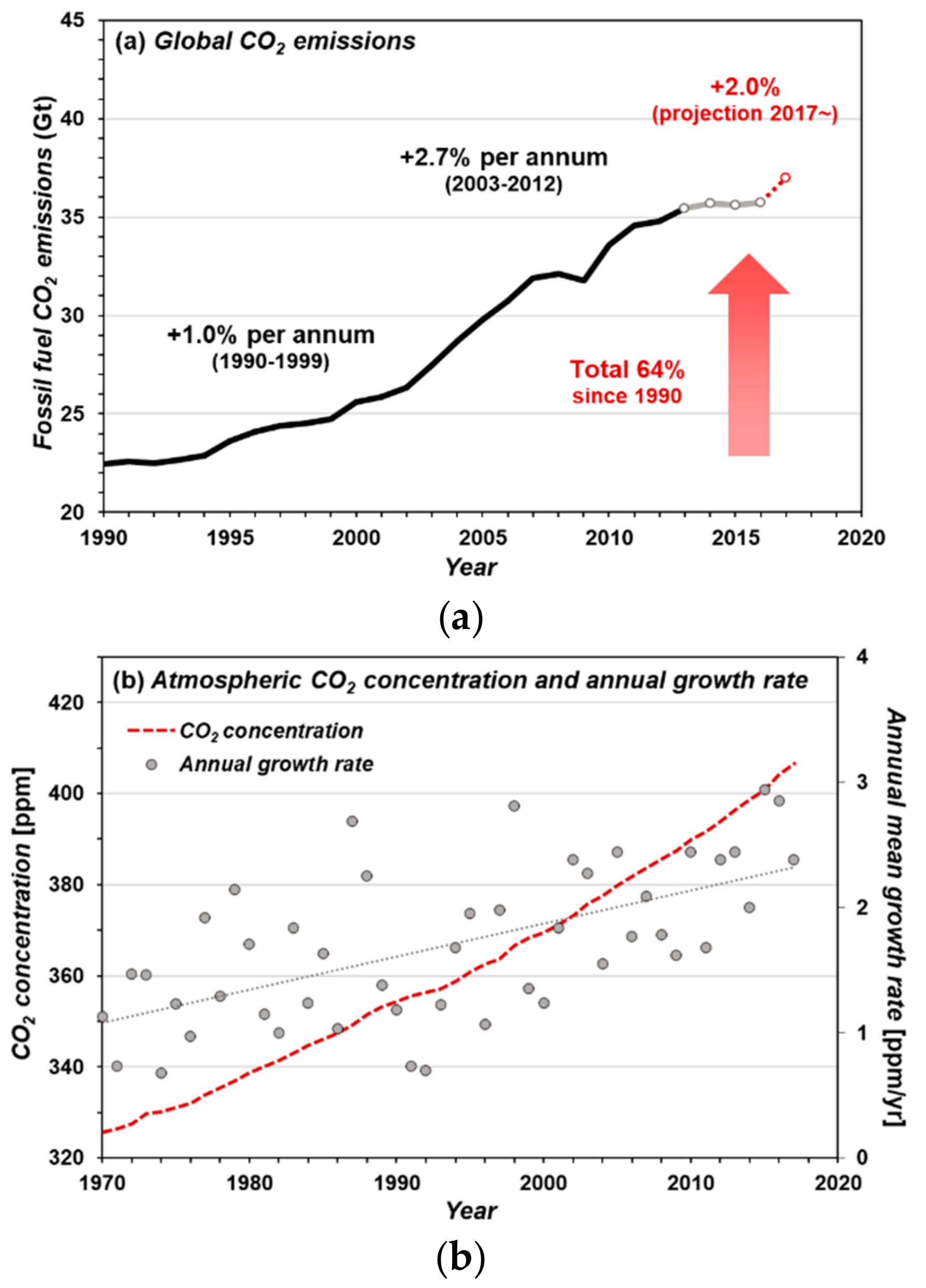

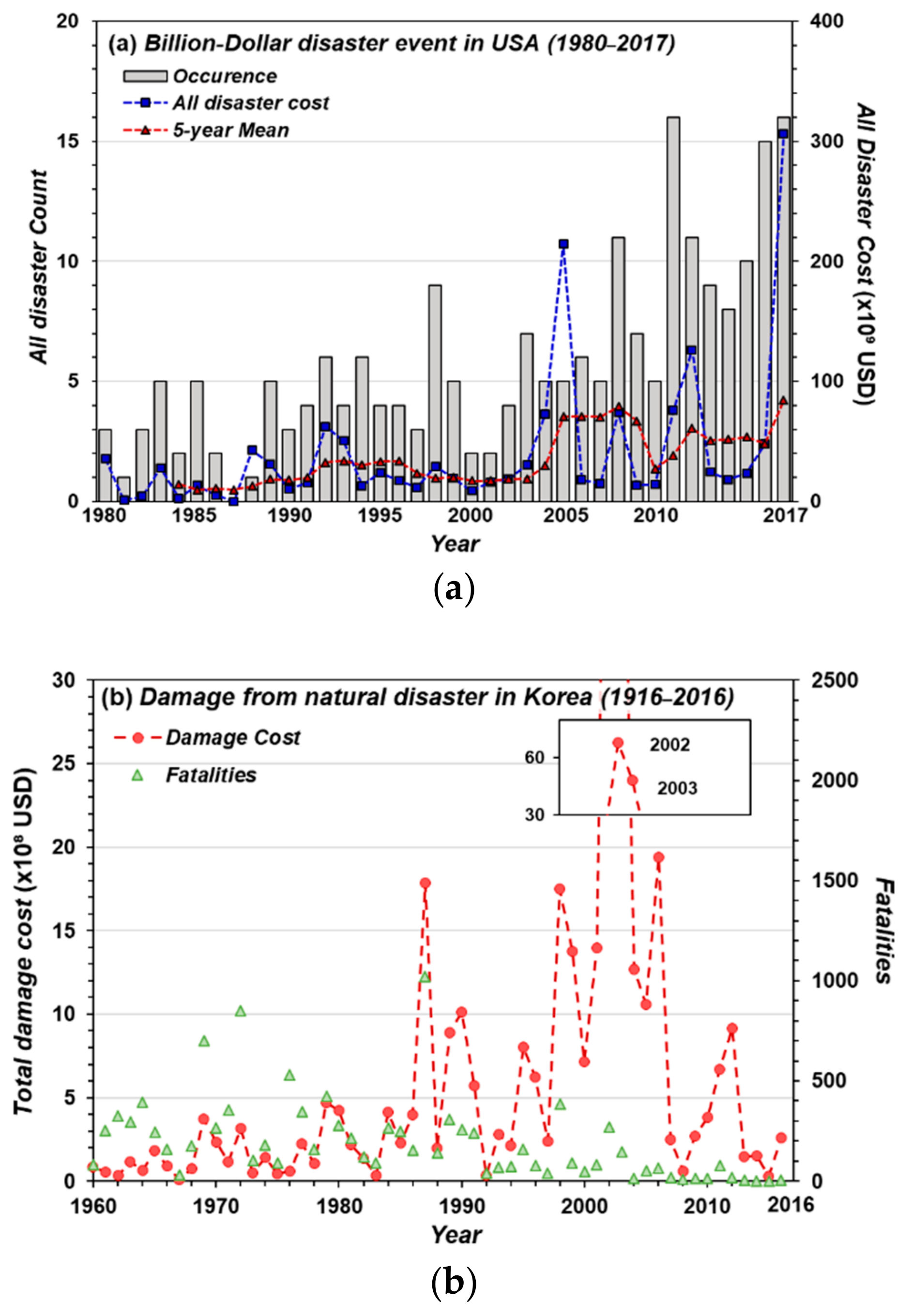
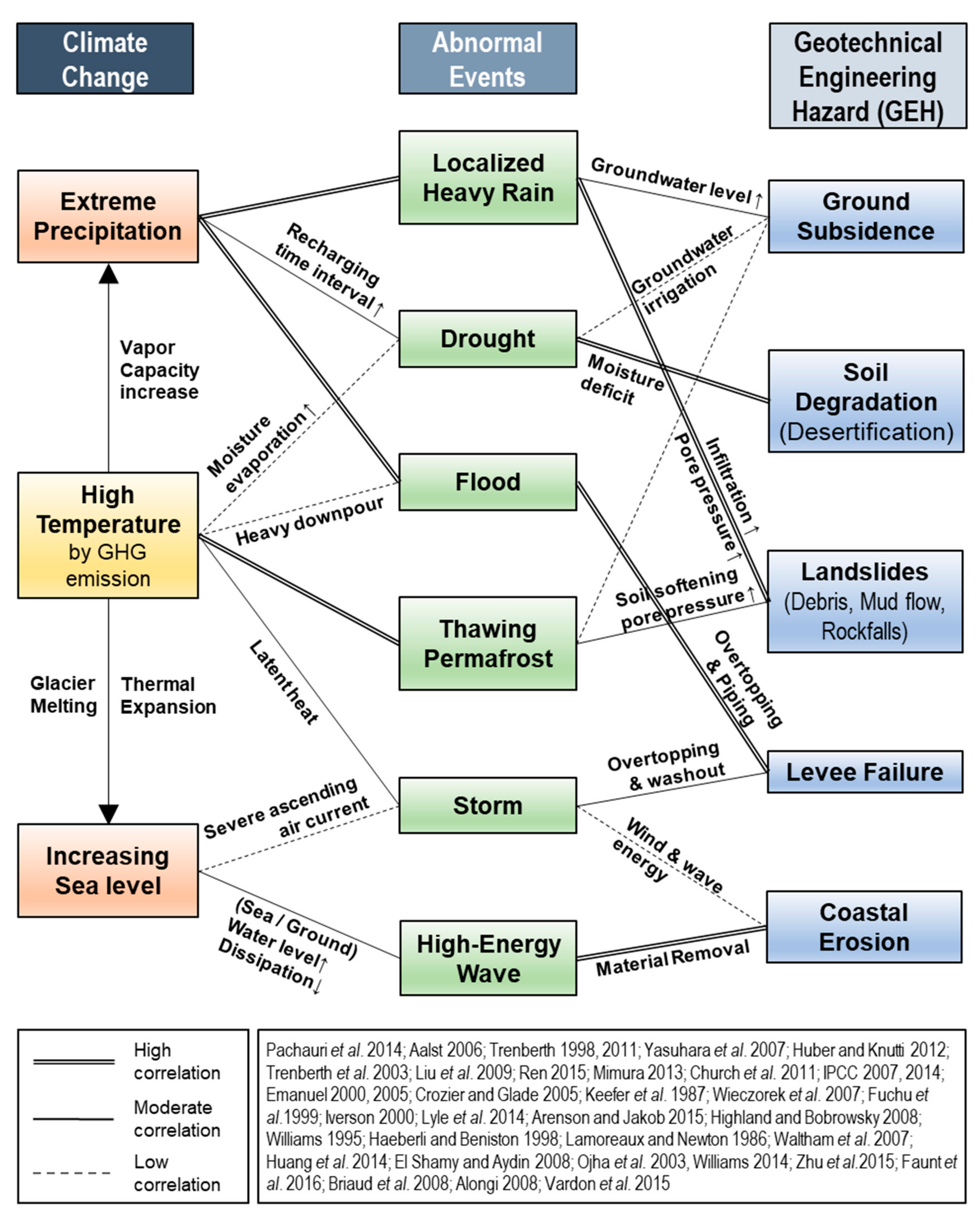
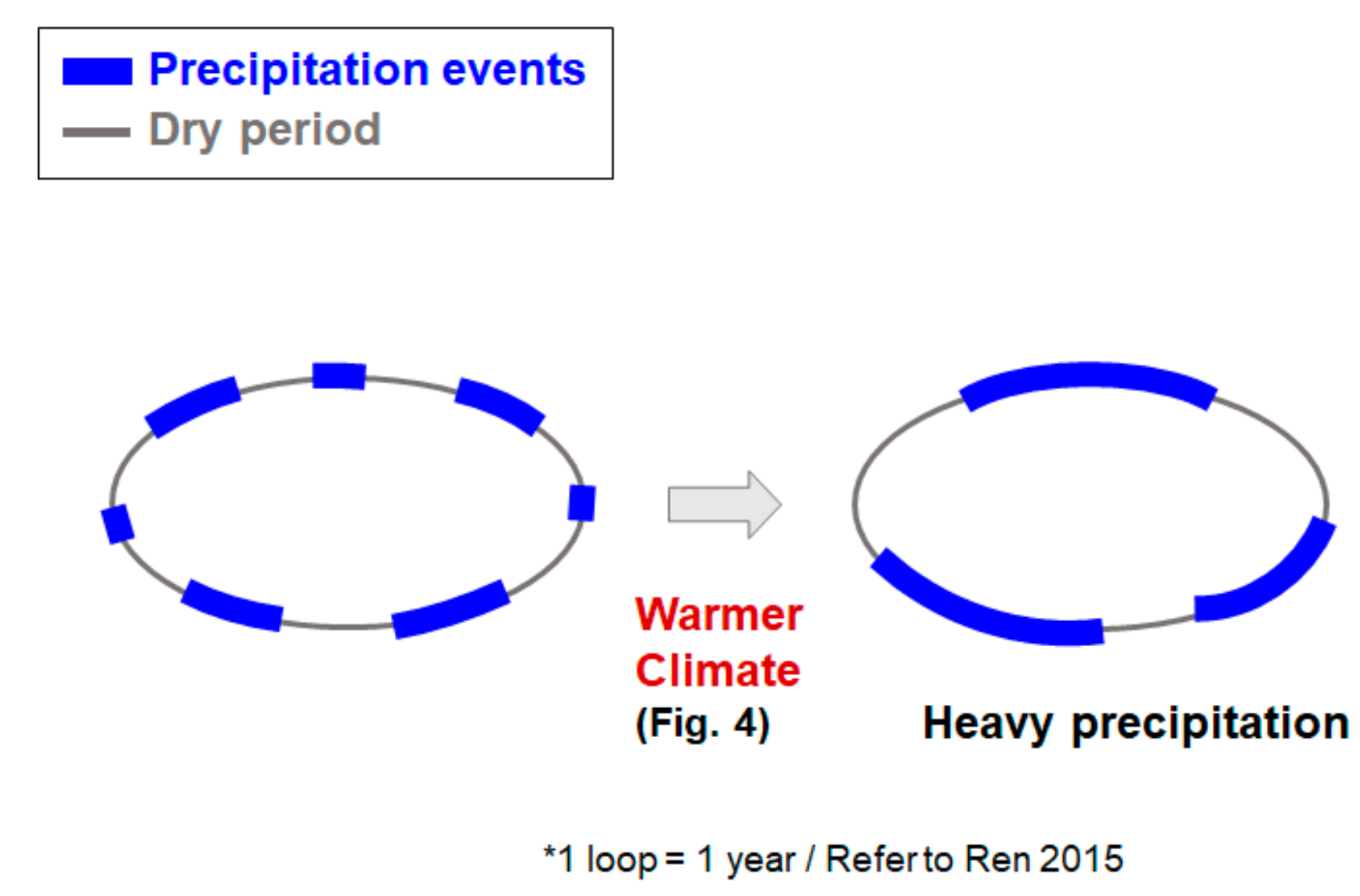

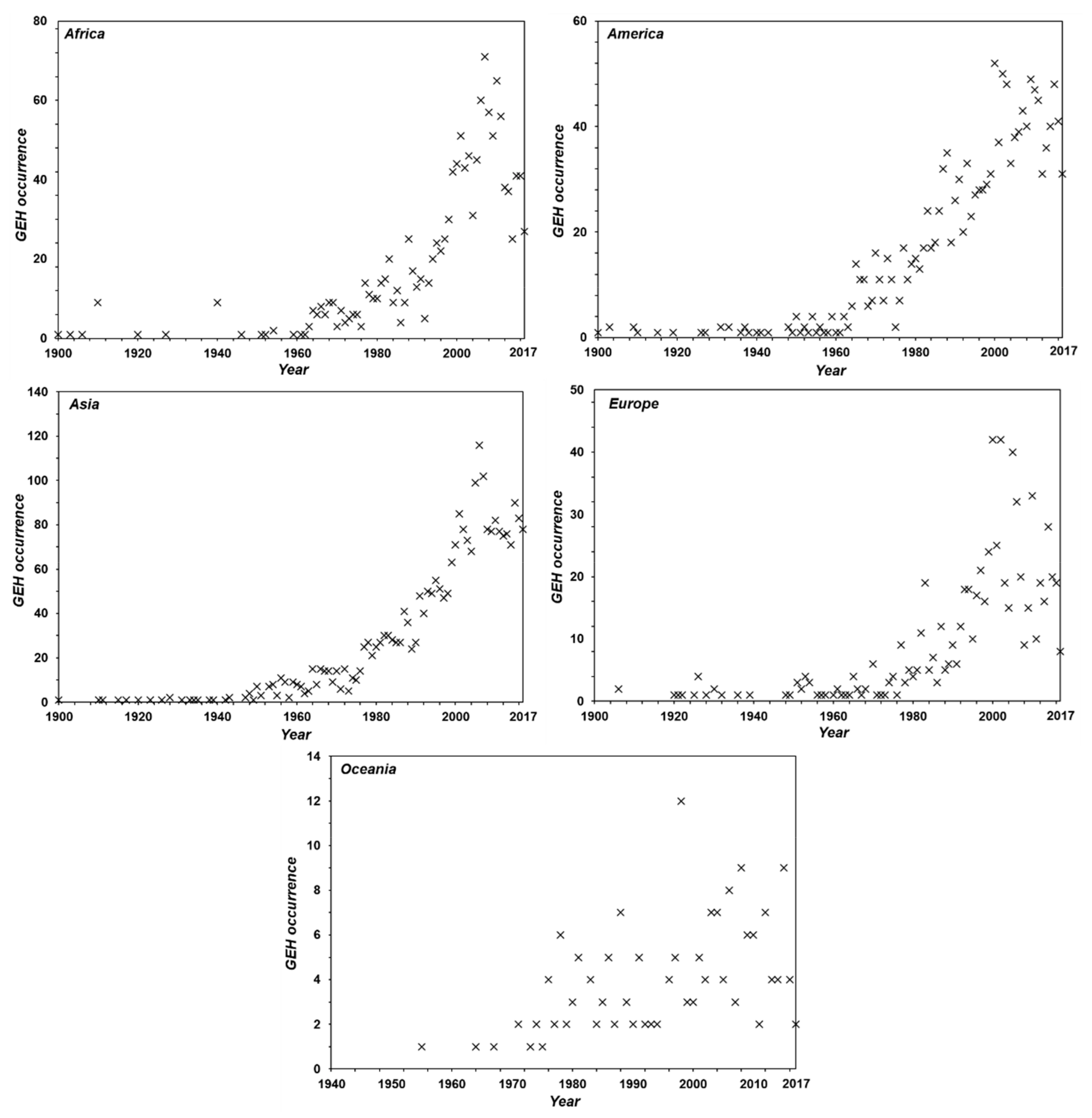
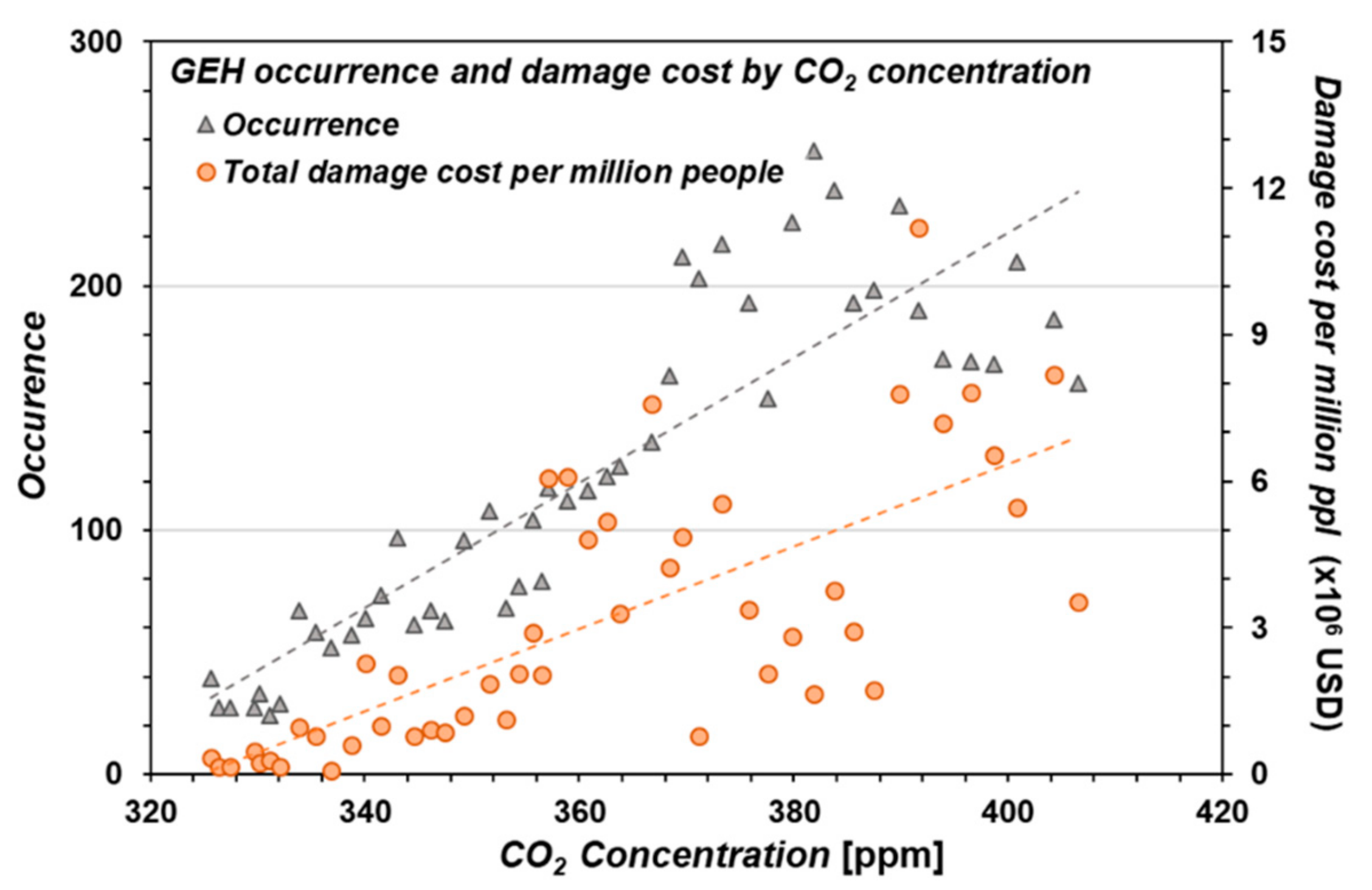
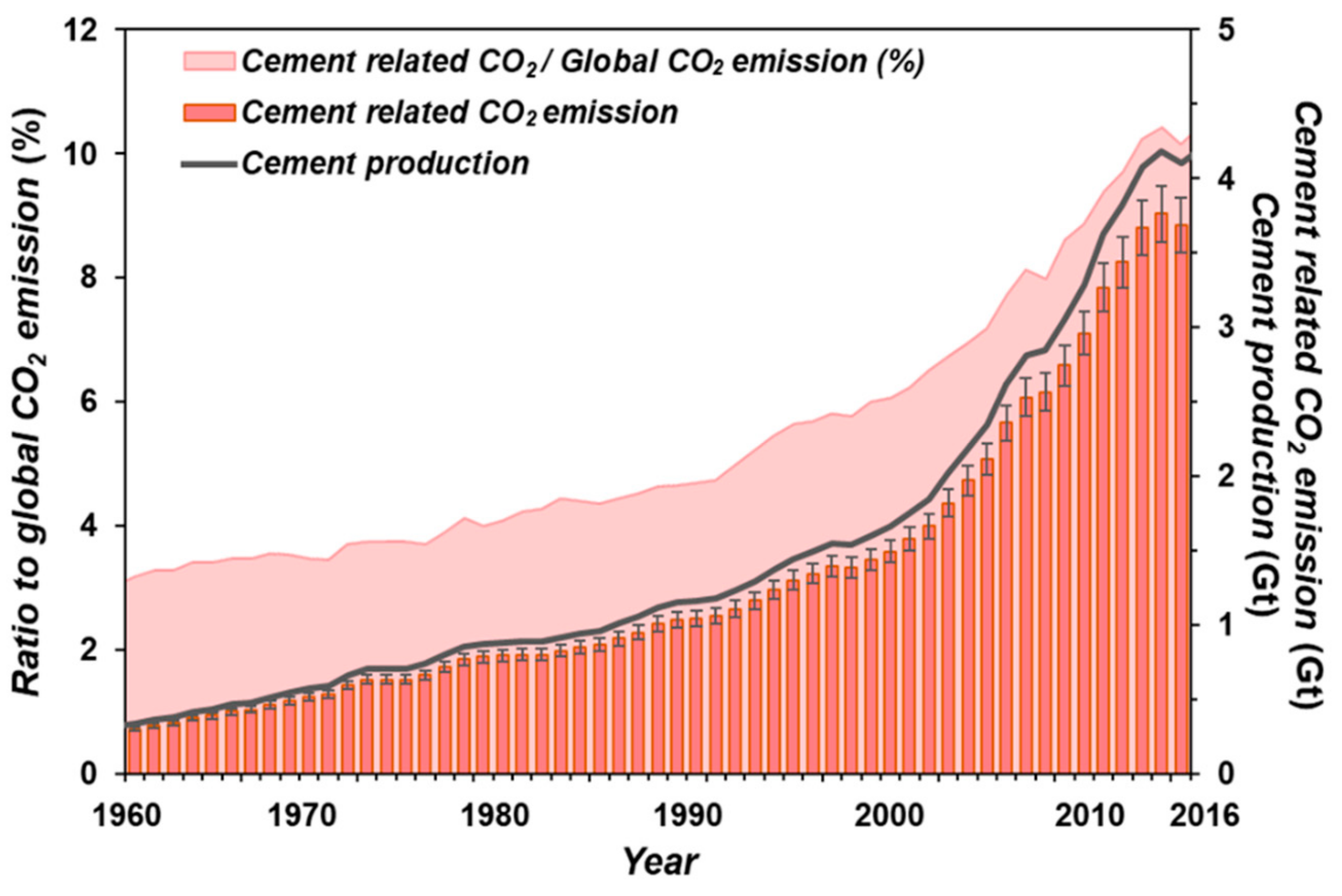
| Abnormal Climate Event | Effect on Ground Properties | Related Geo-Hazard | References | |
|---|---|---|---|---|
| Extreme Precipitation | Localized Heavy Rain | Pore pressure increase → Soil suction value decrease → Soil effective stress and shear strength reduction | Landslide | [35,36,37,38] |
| Higher infiltration into surface layer → Unit weight increase above potential failure surface → Increased driving force inducing downward movement | Landslide | |||
| Flood → Rise of seepage line or overtopping, which increases the degree of saturation due to infiltration → Pore pressure increase → Void ratio and hydraulic conductivity increase → Effective stress decrease | Levee failure (breach, piping) | [45,46,47,59] | ||
| Extreme groundwater table variation and dissolution of soluble geomaterials (e.g., CaCO3) | Ground Subsidence (including sinkholes) | [43,44] | ||
| Drought | Severe evaporation → Moisture deficit in surface soil → External soil shrinkage and internal erosion → Vegetation cover decay and soil vulnerability (erosion) increase | Soil degradation (Desertification) Ground subsidence | [48,49,50,53] | |
| High Average Temperature | Thawing Permafrost | Destruction of ice-cementation bonds and unfrozen water increase in soil → Shear strength decrease | Landslide Heaving and subsidence (including thermokarst) | [33,39,41,42] |
| Sea Level Rise | Higher water level on coasts → Less wave energy dissipation → Higher wave energy approaching coasts → Air trapping in pore spaces and compression by waves → Weakening of soil particle interaction → Break off and coastal erosion increase | Coastal Erosion Coastal Landslide | [17,51,52] | |
| Latent heat energy and vapor transfer to the air → Severe and higher air ascending stream (heavy storm) → Extensive and frequent inundation by storm surges in coastal regions → Overtopping and washing out → Erosion and failure | Coastal Erosion Levee Failure | |||
| Properties | Chemical Stabilizer | Geopolymer | Geosynthetics | Microbiologically Induced Calcite Precipitation | Biopolymer |
|---|---|---|---|---|---|
| Methodology | Injection or spraying and mixing before compaction | Mixing, injecting, or spraying of alkali activated pozzolans | In situ installation of synthetic materials | Injecting bacteria and nutrient solution into the ground | Direct mixing, injecting, or spraying of biopolymers |
| Materials and Mechanism | Chemically synthesized polymers (i.e., acrylamide-based anionic polyelectrolytes) | Alumina-silicate (i.e., pozzolanic materials) and alkali or alkali earth substance | Synthetized polymer products | Microbial (bacterial) and urease enzyme | Dry (powder type) of hydrogel (solution) biopolymers |
| Ionic bonding with soil particles or interparticle cementation | Alkali silicate activation (polycondensation) | Tensile strength enhancement and fluid flow control in soil | Biologically driven CaCO3 precipitation (cementation, pore-clogging) | Particle aggregation of inter-particle bonding through hydrogen and ionic bonding | |
| Geotechnical Effects | -Strength improvement and density increase -Reduced sensitivity to water (plasticity) | Void ratio reduction by geopolymerized gel filling and increased bulk density | -Separation, filtration, and drainage of water in soil -Tensile strengthening -Impeding flow of liquid or gas | -Improvement in soil matrix stiffness and initial shear strength -Hydraulic conductivity control | -Cohesion and strength increase (biopolymer–soil matrix formation) -Permeability reduction |
| Advantages | -Prevention of detachment by erosion and runoff -Encouraged seed germination -Flocculants for wastewater treatment -Increased sweep efficiency in oil recovery | -Lower CO2 emissions than cement -Resistance to acid, sulfate, and freeze–thaw attack -Usage of industrial by-products (fly and bottom ashes) | -High durability -Easy transportation and site installation -High tensile strength, flexibility, and imperviousness -Various ranges of applications | -Low energy consumption, with a low carbon footprint -Flexible implementation in soil due to easy control of the treatment process, using bacteria -Chemical characteristic of soil grains do not alter | -Low carbon footprint and biodegradability -Low binder quantity -Sufficient quality control -Erosion reduction and vegetation improvement |
| Limitations and Challenges | -Contamination concerns into soil and ground water -High material cost -Infeasible for deep/thick ground treatment | -Lack of standards for tests and production -Lack of geotechnical applications -Needs heat process (about 60 °C) in the field | -Material-dependent strength -Non-biodegradable -Inappropriate for significant depths in the ground | -Inappropriate for fine - soils-Consistent quality control -Weakness against low pH -Ammonia as a byproduct -Few field applications | -Low economic feasibility -High sensitivity to water -Severe hydrogel swelling -Concerns on long-term durability |
| Related Recent Research | -Monitoring of long-term effectiveness by measuring metal bioavailability and soil quality improvement -Biomass silica stabilizer from agricultural waste -Calcium carbide residue from acetylene production | -Attempt to use lime sludge from paper industry waste for paving blocks -Soft marine clay stabilization by fly ash and calcium carbide residue-based geopolymer | -Nano clay combined geotextile for removing heavy metal or toxic manners -Hybrid combined geosynthetics -Sensor-embedded geosynthetics | -Field-scale test focused on surface applications for erosion and dust control -Use of seawater as a calcium source (feasibility for marine applications) | -Casein from dairy waste as a new binder -Inter-particle interaction characterization using microscopic devices -Strength enhancement in wet conditions using crosslinking -Economic feasibility improve |
| Reference | [86,87,88,89,90,91,92] | [93,94,95,96,97,98,99,100,101] | [102,103,104,105,106,107,108] | [109,110,111,112,113,114,115,116,117] | [23,118,119,120,121,122,123,124,125,126,127] |
© 2019 by the authors. Licensee MDPI, Basel, Switzerland. This article is an open access article distributed under the terms and conditions of the Creative Commons Attribution (CC BY) license (http://creativecommons.org/licenses/by/4.0/).
Share and Cite
Chang, I.; Lee, M.; Cho, G.-C. Global CO2 Emission-Related Geotechnical Engineering Hazards and the Mission for Sustainable Geotechnical Engineering. Energies 2019, 12, 2567. https://doi.org/10.3390/en12132567
Chang I, Lee M, Cho G-C. Global CO2 Emission-Related Geotechnical Engineering Hazards and the Mission for Sustainable Geotechnical Engineering. Energies. 2019; 12(13):2567. https://doi.org/10.3390/en12132567
Chicago/Turabian StyleChang, Ilhan, Minhyeong Lee, and Gye-Chun Cho. 2019. "Global CO2 Emission-Related Geotechnical Engineering Hazards and the Mission for Sustainable Geotechnical Engineering" Energies 12, no. 13: 2567. https://doi.org/10.3390/en12132567
APA StyleChang, I., Lee, M., & Cho, G.-C. (2019). Global CO2 Emission-Related Geotechnical Engineering Hazards and the Mission for Sustainable Geotechnical Engineering. Energies, 12(13), 2567. https://doi.org/10.3390/en12132567







